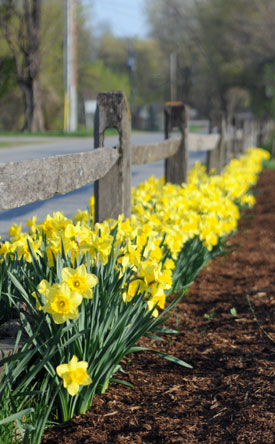





As a founding employee of Gardener's Supply, I wore many different hats over the years. Currently, I have my own company called Johnnie Brook Creative. The gardens around my home in Richmond, VT, include a large vegetable garden, seasonal greenhouse, cutting garden, perennial gardens, rock garden, shade garden, berry plantings, lots of container plants and a meadow garden. There's no place I'd rather be than in the garden.
 Daffodils are especially nice when planted in masses. Don't be skimpy.
Daffodils are especially nice when planted in masses. Don't be skimpy.
When it comes to generating seductive plant photography, Dutch bulb growers are the champs. Almost every photograph of spring bulbs we see is produced in Holland by the Netherlands flower bulb industry. Their closeup shots show each satiny blossom to perfection, complete with glistening dew drops. Gardens bloom in perfectly timed, perfectly color coordinated splendor. And what about those acres of red tulips, rivers of blue hyacinths, and entire woodlands carpeted with crocuses? What gardener can resist?
Not me. Though thousands of naturalized flower bulbs now fill my yard and gardens, those images still captivate me, and I add a few more every year. Each humble brown bulb is a surprise package filled with color and fragrance. A floral time bomb ticking off the days until spring.
No matter how large or small your garden, almost everyone has room for a few spring bulbs. Here are a some tips to help ensure your success:
Bigger is BetterThese days you can buy bulbs almost everywhere--including the grocery store and big-box stores. The price may be right, but most of these bulbs are undersized. And when it comes to bulbs, the bigger the bulb you plant, the bigger the bloom next spring. A bigger bulb also increases the likelihood that your bulbs will flower for more than one year.
Dutch bulbs are graded by size, and reputable bulb suppliers will list the size of their bulbs in centimeters of circumference. Only the largest, highest-quality bulbs can be listed as "top size." Top-size tulip bulbs, for instance, must be at least 12 centimeters in circumference. Discount bulbs are B-grade bulbs that couldn't make the top-size grade.
Quality MattersNext year's flower is already fully formed inside the bulb. If the bulbs aren't handled with care, the flower inside can be damaged. Bulbs will dry out if they're exposed to heat, dry air and light. If they're too moist, they can get moldy or mushy. Look for bulbs that are firm and free of large blemishes or scars. A spot or two of mold is OK, but more means they've been improperly stored. The bulb should be dormant, which means you should see little or no root growth. For best results, bulbs should be kept in cold storage with controlled humidity until being shipped to you. This is why I usually purchase my bulbs by mail from a direct importer.
Plant With CareMost bulbs require well-drained soil and full or partial sun. Planting depth is also important. A general rule is to measure the height of the bulb itself and then plant it three to four times deeper than that. For a tulip bulb 2 inches high, you need to dig a hole that's at least six to eight inches deep. Before you put the bulb into place, loosen the soil an inch or two deeper and add some granular fertilizer, such as our granular All-Purpose Fertilizer.
Don't Be StingyBulbs look best in closely planted, informal clusters of three, five, seven or nine. Large bulbs, such as tulips and hyacinths, can be spaced 5 to 6 inches apart. Smaller bulbs, such as crocus and scilla, should be placed no more than one to three inches apart. If you can only plant ten tulips, put them in two groups of five or one group of ten. Ones and twos or a row of tulip soldiers will be disappointing.
Let the Foliage RipenOnce your bulbs have bloomed, remove the spent flowers to prevent the plants from expending energy to develop seeds. Next year's flower forms during the three or four weeks after flowering. During this time the plant needs its leaves to generate the nutrients to form a new flower. It's important to leave the foliage alone until it yellows and begins to wither. At that point, you can cut the foliage or gently tug on it to pull it away from the bulb.
Late summer is the time to pull out your bulb catalogs, visit your local nursery, or spend some time shopping for bulbs online. Spring bulbs need to establish a strong root system before the soil freezes. This means that if you're a northern gardener, you should get your bulbs into the ground in early to mid-fall (don't wait for a finger-freezing day in late October). Southern gardeners can wait until early winter to plant.
Copyright © www.100flowers.win Botanic Garden All Rights Reserved